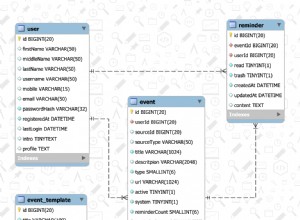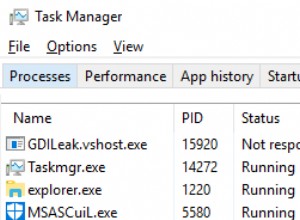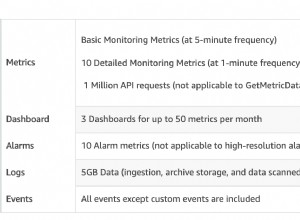El valor de indexar
PostgreSQL proporciona un operador de distancia lineal simple <-> (distancia lineal). Usaremos esto para encontrar los puntos más cercanos a una ubicación determinada.
PostgreSQL proporciona un operador de distancia lineal simple para los datos y, al no realizar optimizaciones ni tener índices, vemos el siguiente plan de ejecución:
time psql -qtAc "
EXPLAIN (ANALYZE ON, BUFFERS ON)
SELECT name, location
FROM geonames
ORDER BY location <-> '(29.9691,-95.6972)'
LIMIT 5;
" <-- closing quote
QUERY PLAN
-----------------------------------------------------------------------------------------------------------
Limit (cost=418749.15..418749.73 rows=5 width=38)
(actual time=2553.970..2555.673 rows=5 loops=1)
Buffers: shared hit=100 read=272836
-> Gather Merge (cost=418749.15..1580358.21 rows=9955954 width=38)
(actual time=2553.969..2555.669 rows=5 loops=1)
Workers Planned: 2
Workers Launched: 2
Buffers: shared hit=100 read=272836
-> Sort (cost=417749.12..430194.06 rows=4977977 width=38)
(actual time=2548.220..2548.221 rows=4 loops=3)
Sort Key: ((location <-> '(29.9691,-95.6972)'::point))
Sort Method: top-N heapsort Memory: 25kB
Worker 0: Sort Method: top-N heapsort Memory: 26kB
Worker 1: Sort Method: top-N heapsort Memory: 25kB
Buffers: shared hit=100 read=272836
-> Parallel Seq Scan on geonames (cost=0.00..335066.71 rows=4977977 width=38)
(actual time=0.040..1637.884 rows=3982382 loops=3)
Buffers: shared hit=6 read=272836
Planning Time: 0.493 ms
Execution Time: 2555.737 ms
real 0m2.595s
user 0m0.011s
sys 0m0.015s
y estos son los resultados:(los mismos resultados para todas las solicitudes, por lo que los omitiremos más adelante).
| nombre | ubicación |
|---|---|
| Ciprés | (29.96911,-95.69717) |
| Iglesia Bautista Cypress Pointe | (29.9732,-95.6873) |
| Oficina postal de Cypress | (29.9743,-95.67953) |
| Pozos calientes | (29.95689,-95.68189) |
| Aeropuerto de Dry Creek | (29.98571,-95.68597) |
Entonces, 418749.73 es el costo de optimización de OPTIMIZER, y se necesitaron dos segundos y medio (2555.673) para ejecutar esa consulta. Este es realmente un muy buen resultado, usando PostgreSQL sin ninguna optimización contra una tabla de 11 millones de filas. Esta es también la razón por la que seleccionamos un conjunto de datos más grande, ya que habría una diferencia mínima al usar índices en menos de 10 millones de filas. Los escaneos secuenciales paralelos son fantásticos, pero ese es otro artículo.
Agregar índice GiST
Comenzamos el proceso de optimización agregando un índice GiST. Porque nuestra consulta de ejemplo tiene un
LIMIT
cláusula de 5 artículos, tenemos una selectividad muy alta. Esto alentará al planificador a usar un índice, por lo que proporcionaremos uno que funcione bastante bien con los datos geométricos.
time psql -qtAc "CREATE INDEX idx_gist_geonames_location ON geonames USING gist(location);"
El acto de crear el índice tiene un poco de gasto.
CREATE INDEX
real 3m1.988s
user 0m0.011s
sys 0m0.014s
Y luego vuelva a ejecutar la misma consulta.
time psql -qtAc "
EXPLAIN (ANALYZE ON, BUFFERS ON)
SELECT name, location
FROM geonames
ORDER BY location <-> '(29.9691,-95.6972)'
LIMIT 5;
"
QUERY PLAN
----------------------------------------------------------------------------------
Limit (cost=0.42..1.16 rows=5 width=38) (actual time=0.797..0.881 rows=5 loops=1)
Buffers: shared hit=5 read=15
-> Index Scan using idx_gist_geonames_location on geonames
(cost=0.42..1773715.32 rows=11947145 width=38)
(actual time=0.796..0.879 rows=5 loops=1)
Order By: (location <-> '(29.9691,-95.6972)'::point)
Buffers: shared hit=5 read=15
Planning Time: 0.768 ms
Execution Time: 0.939 ms
real 0m0.033s
user 0m0.011s
sys 0m0.013s
En este caso, vemos una mejora bastante dramática. ¡El costo estimado de la consulta es de solo 1,16! Compare eso con el costo original de la consulta no optimizada en 418749.73. El tiempo real empleado fue de 0,939 milisegundos (nueve décimas de milisegundo), que se compara con los 2,5 segundos de la consulta original. Este resultado tomó menos tiempo para planificar, obtuvo una estimación dramáticamente mejor y tomó alrededor de 3 órdenes de magnitud menos tiempo de ejecución.
Veamos si podemos hacerlo mejor.
Agregar un índice SP-GiST
time psql -qtAc "CREATE INDEX idx_spgist_geonames_location ON geonames USING spgist(location);"
CREATE INDEX
real 1m25.205s
user 0m0.010s
sys 0m0.015s
Y luego ejecutamos la misma consulta nuevamente.
time psql -qtAc "
EXPLAIN (ANALYZE ON, BUFFERS ON)
SELECT name, location
FROM geonames
ORDER BY location <-> '(29.9691,-95.6972)'
LIMIT 5;
"
QUERY PLAN
-----------------------------------------------------------------------------------
Limit (cost=0.42..1.09 rows=5 width=38) (actual time=0.066..0.323 rows=5 loops=1)
Buffers: shared hit=47
-> Index Scan using idx_spgist_geonames_location on geonames
(cost=0.42..1598071.32 rows=11947145 width=38)
(actual time=0.065..0.320 rows=5 loops=1)
Order By: (location <-> '(29.9691,-95.6972)'::point)
Buffers: shared hit=47
Planning Time: 0.122 ms
Execution Time: 0.358 ms
(7 rows)
real 0m0.040s
user 0m0.011s
sys 0m0.015s
¡Guau! Ahora, usando un índice SP-GiST, la consulta cuesta solo 1,09 y se ejecuta en 0,358 milisegundos (un tercio de milisegundo).
Examinemos algunas cosas sobre los propios índices y veamos cómo se apilan entre sí en el disco.
Comparaciones de índices
| nombre del índice | hora de creación | estimar | tiempo de consulta | tamaño del índice | planear tiempo |
|---|---|---|---|---|---|
| sin indexar | 0S | 418749.73 | 2555.673 | 0 | .493 |
| idx_gist_geonames_ubicación | 3M 1S | 1.16 | .939ms | 868 MB | .786 |
| idx_spgist_geonames_ubicación | 1M 25S | 1.09 | .358ms | 523 MB | .122 |
Conclusiones
Entonces, vemos que SP-GiST tiene el doble de velocidad de ejecución que GiST, 8 veces más rápido para planificar y aproximadamente el 60 % del tamaño en disco. Y (relevante para este artículo) también es compatible con la búsqueda de índices KNN a partir de PostgreSQL 12. Para este tipo de operación, tenemos un claro ganador.
Apéndices
Configurando los datos
Para este artículo, vamos a utilizar los datos proporcionados por GeoNames Gazetteer.
Este trabajo tiene una licencia Creative Commons Attribution 4.0 License
Los datos se proporcionan "tal cual" sin garantía ni ninguna representación de exactitud, puntualidad o integridad.
Crear la estructura
Comenzamos el proceso creando un directorio de trabajo y un poco de ETL.
# change to our home directory
cd
mkdir spgist
cd spgist
# get the base data.
# This file is 350MB. It will unpack to 1.5GB
# It will expand to 2GB in PostgreSQL,
# and then you will still need some room for indexes
# All together, you will need about
# 3GB of space for this exercise
# for about 12M rows of data.
psql -qtAc "
CREATE TABLE IF NOT EXISTS geonames (
geonameid integer primary key
,name text
,asciiname text
,alternatenames text
,latitude numeric(13,5)
,longitude numeric(13,5)
,feature_class text
,feature_code text
,country text
,cc2 text
,admin1 text
,admin2 bigint
,admin3 bigint
,admin4 bigint
,population bigint
,elevation bigint
,dem bigint
,timezone text
,modification date );
COMMENT ON COLUMN geonames.geonameid
IS ' integer id of record in geonames database';
COMMENT ON COLUMN geonames.name
IS ' name of geographical point (utf8) varchar(200)';
COMMENT ON COLUMN geonames.asciiname
IS ' name of geographical point in plain ascii characters, varchar(200)';
COMMENT ON COLUMN geonames.alternatenames
IS ' alternatenames, comma separated, ascii names automatically transliterated,
convenience attribute from alternatename table, varchar(10000)';
COMMENT ON COLUMN geonames.latitude
IS ' latitude in decimal degrees (wgs84)';
COMMENT ON COLUMN geonames.longitude
IS ' longitude in decimal degrees (wgs84)';
COMMENT ON COLUMN geonames.feature_class
IS ' http://www.geonames.org/export/codes.html, char(1)';
COMMENT ON COLUMN geonames.feature_code
IS ' http://www.geonames.org/export/codes.html, varchar(10)';
COMMENT ON COLUMN geonames.country
IS ' ISO-3166 2-letter country code, 2 characters';
COMMENT ON COLUMN geonames.cc2
IS ' alternate country codes, comma separated, ISO-3166 2-letter country code,
200 characters';
COMMENT ON COLUMN geonames.admin1
IS ' fipscode (subject to change to iso code), see exceptions below,
see file admin1Codes.txt for display names of this code; varchar(20)';
COMMENT ON COLUMN geonames.admin2
IS ' code for the second administrative division, a county in the US,
see file admin2Codes.txt; varchar(80) ';
COMMENT ON COLUMN geonames.admin3
IS ' code for third level administrative division, varchar(20)';
COMMENT ON COLUMN geonames.admin4
IS ' code for fourth level administrative division, varchar(20)';
COMMENT ON COLUMN geonames.population
IS ' bigint (8 byte int) ';
COMMENT ON COLUMN geonames.elevation
IS ' in meters, integer';
COMMENT ON COLUMN geonames.dem
IS ' digital elevation model, srtm3 or gtopo30, average elevation of 3''x3''
(ca 90mx90m) or 30''x30'' (ca 900mx900m) area in meters, integer.
srtm processed by cgiar/ciat.';
COMMENT ON COLUMN geonames.timezone
IS ' the iana timezone id (see file timeZone.txt) varchar(40)';
COMMENT ON COLUMN geonames.modification
IS ' date of last modification in yyyy-MM-dd format';
" #<-- Don't forget the closing quote
ETL
wget http://download.geonames.org/export/dump/allCountries.zip
unzip allCountries.zip
# do this, and go get a coffee. This took nearly an hour
# there will be a few lines that fail, they don't really matter much
IFS=$'\n'
for line in $(<allCountries.txt)
do
echo -n "$line" |
psql -qtAc
"COPY geonames FROM STDIN WITH CSV DELIMITER E'\t';"
2> errors.txt
done
Limpieza y configuración
Todo lo demás lo hacemos desde dentro de psql:
psql
-- This command requires the installation
-- of postgis2 from your OS package manager.
-- For OS/X that was `port install postgresql12-postgis2`
-- it will be something similar on most platforms.
-- (e.g. apt-get install postgresql12-postgis2,
-- yum -y install postgresql12-postgis2, etc.)
CREATE EXTENSION postgis;
CREATE EXTENSION postgis_topology;
ALTER TABLE geonames ADD COLUMN location point;
-- Go get another cup of coffee, this is going to rewrite the entire table with the new geo column.
UPDATE geonames SET location = ('(' || latitude || ', ' || longitude || ')')::point;
DELETE FROM geonames WHERE latitude IS NULL or longitude IS NULL;
-- DELETE 32 -- In my case, this ETL anomoly was too small
-- to bother fixing the records
-- Bloat removal from the update and delete operations
CLUSTER geonames USING geonames_pkey;




